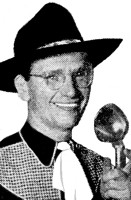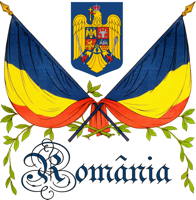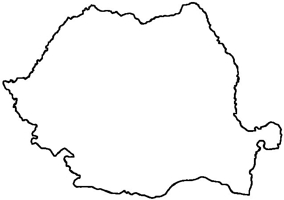
|
The Society of Folk Dance Historians (SFDH)
Folk Dance and Culture in Romania
[
Home |
About |
Encyclopedia | CLICK AN IMAGE TO ENLARGE |

|

 Since the establishment of Romania, the cultural life of the people of that country has been marked by an expansion and development of almost unprecedented scope and depth. The goal of the new society that is being built is the maximum satisfaction of the ever-increasing material and cultural needs of the people.
Since the establishment of Romania, the cultural life of the people of that country has been marked by an expansion and development of almost unprecedented scope and depth. The goal of the new society that is being built is the maximum satisfaction of the ever-increasing material and cultural needs of the people.
And so, on every point of the cultural front there has been increasingly broad activity, even greater expenditures, a steady increase in the facilities available, and in the people's participation in cultural activities.
The new cultural attainments are evident in every aspect of Romanian life today. In the countryside, every village has its House of Culture with its own library, radio receiver, motion picture projector, clubs, and performance groups. In industrial establishments, the factory clubs also have libraries, reading rooms, and auditoriums. There are motion pictures, plays, and lectures almost daily. The factory cultural teams present plays, folk songs and dances, and there are choruses and orchestras.
Among the many organizations and institutions that are taking part in this work, the Institutul Cultural Român (ICR) and its Cluj branch play one of the most important roles.
Established to gather, study, and put to use the treasure of folk art – music, dance, and literature – the objectives and concept of activity of the ICR reflect its role in society. It is not merely an archive, a repository, and a museum for rare, ancient, or forgotten pieces, or for formal scientific research, but in its activity it is linked to life itself, and rejects it just as it is linked to the continual development of the folk-creation that it reflects – resulting from the development of the life of the Romanian people.
The ICR today has in its collection more than 25,000 folk songs and dances recorded, most of them transcribed. This stock, which is continually being enriched by collection and research in the different regions, constitutes the study material that lies at the base of the activity of the ICR.
The collection and scientific study of folklore enriches the knowledge of the artistic life of the people, its process of development in the past, and the whole structure of each achievement of folk art.
This activity is undertaken by three groups in the ICR: one specializing in folk music, another in folk dancing, and the third in folk literature. These groups are differentiated only from the view point of technical requirements, and, of course, they work together on the same folk material, which is looked upon as an organic unit in which music is closely linked to text and to the dance – except for those rare cases of self-contained musical or literary folk creations.
The folklore research that has been carried out in recent years in the various regions of the country has indicated transformations of the folk song in style and content, reflecting the opinions and sentiments of the masses of the people confronted with the developing and changing life of Romania.
Just as the old songs reflected the past, the songs created by the people today reflect the rich and new life of our times.
Research in the different parts of the country has shown, in the richness of the material that has been collected, the new themes of the folk song. The theme of peace and the struggle for peace appears in many songs. Some of these peace songs are new versions, a sort of bringing-up-to-date of old songs, born during the wars, kept alive in the collective memory of the people, and reappearing as a new expression of the people's sentiment.
The music, determined by this new content, has also been transformed. Most of the new songs in the Gorj Region, for example, in contrast to the old songs, have the dance rhythm of the sârba or hora. One of the most widely sung songs of this kind is the Peace Hora.
Play us the hora, violins,
The Hora of Peace among the peoples.
Other new elements in the themes of the folk songs reflect the attitudes of the people to the new life in Romania, sing about the coming to power of the regime of people's democracy, about the new man, free, working to strengthen his country, the collectivization of the farms, etc. – essential preoccupations of the life of the people, evidencing a new social consciousness.
This theme appears very strongly in the songs. Thus, at the village of Ieud, in the Rodna Region, a popular song refers to the establishment of the collective farm and the anger of the kulaks (the term used towards the end of the Russian Empire to describe peasants with over 8 acres of land).
It makes them mad, it fills them with rage,
That we have founded a collective farm.
Research on the folksong in Bătrâni Comuna (commune) and Prahova Județ (county) has shown the continual development and transformation of folklore since WW1. In these songs, there appeared elements reflecting a new consciousness of their rights and of the possibility of a new life inspired by the Russian revolution, or about the fake "division of the land" by the bourgeois governments, etc.
At the same time as the content of the songs changed, the music was also transformed in style. It became mor optimistic, more dynamic, and more forceful through the adoption of a lovely rhythm, closer to dance rhythm, a measured rhythm in contrast to the free rhythm (rubato and parlando) of the old songs. This change in style is equally characteristic of the whole proces of development of the folk songs of today.
Another aspect of the work of the ICR is that which is linked to the creative activity of the composers, and that of the amateur artistic groups in the unions and Houses of Culture in the rural areas.
Folklore is a basic element for the composers in the creation of a realistic art, in which the folk song and dance offer not only an expression of the life of the people, but also the essential characteristics of the musical language of the people. Through research into the popular song, the particular characteristics of the different regions, the numerous variations of the same song, the composers have been given not only the raw material in the form of the collected texts and music, but also they have been assured the possibility of assimilating the essential elements of the style and language of folk music, close to the actual feelings of the people and so necessary for a national form in the work of the composers.
On the same level, the folk instrument orchestra of the ICR links scientific works with musical practice. This experimental orchestra serves to apply the results of research. The various groups of instruments present specific aspects of folk music – new timbres, unpublished effects, color, etc. – that offer composers the means of enriching their orchestrations.
The repertoire of the Barbu Lăutaru orchestra – transferred to the Filarmonica "George Enescu" (George Enescu Philharmonic) in București (Bucharest) in 1953 – is made up of folk songs and dances presented in varied manner in special arrangements, to define the folk style and instrumental coloring.
In addition to the orchestra, there is a school of folk instruments (panpipes, mandolin, and cembalo or harpsichord) that seeks to resolve problems of the scientific teaching of these instruments.
All over the country, orchestras of the same type have been established and give concerts in the village Houses of Culture and at trade union artistic affairs.
An important part of the activity of the ICR is in lending guidance to the work of these amateur groups in the unions and the cultural centers. In 1954, the ICR worked closely with the artistic groups in the Teleorman Region. Orientation groups from the ICR are now at work with the local song and dance organizations in many sections of the country.
The ever increasing number of these amateur groups in towns and villages, the increase in the artistic level of their performances, as demonstrated each year at the competition of amateur art groups, is because in general to the fact that the government stimulates and encourages cultural activity and to the effective contribution of the ICR.
The ICR also does considerable work in the study of the folk dances, the collecting of games, and in making color photographs of costumes; it transcribes the texts of folk tales and undertakes the diffusion of folklore by means of lectures, studies, and articles published in magazines and in a variety of other ways.
The few essential aspects that have been mentioned indicate the general nature of the activity of the ICR, which puts to use the artistic resources of the Romanian people through the study of the developmental laws of folklore, linked to the historic development of the people, through the fact that it promotes folklore among the broad masses of the people and stimulates new creation, thus contributing to the growth of a realistic art in Romania.
In these ways, the ICR participates in the cultural artistic activities that are so widespread today in Romania.
The quality of many of the amateur dance groups and folk choruses of the Houses of Culture and the trade organizations is really wonderful; the Ansamblul Federației Generale a Muncii (Ensemble of the General Federation of Labor) was enormously successful in its performance in Finland at the Olympics in 1952. They gave a song and dance performance at Kapila before an audience of more than 1,000 athletes from Britain, the United States, Western Germany, Australia, South Africa, Japan, New Zealand, Mexico, Brazil, Argentina, and the countries of Scandinavia that drew rounds of applause.
DOCUMENTS
- Romania, a country.
- Romania's Călușarii, an article.
- Romanian Dance and Music, an article.
- Romanian Folk Music Instruments, an article.
- Romanian Folklore, an article.
- Romanian Pipes of Pan, an article.
- Rod La Farge, an article.
Printed in Rosin the Bow, Vol. 5, No. 9, Autumn 1955.
This page © 2018 by Ron Houston.
Please do not copy any part of this page without including this copyright notice.
Please do not copy small portions out of context.
Please do not copy large portions without permission from Ron Houston.